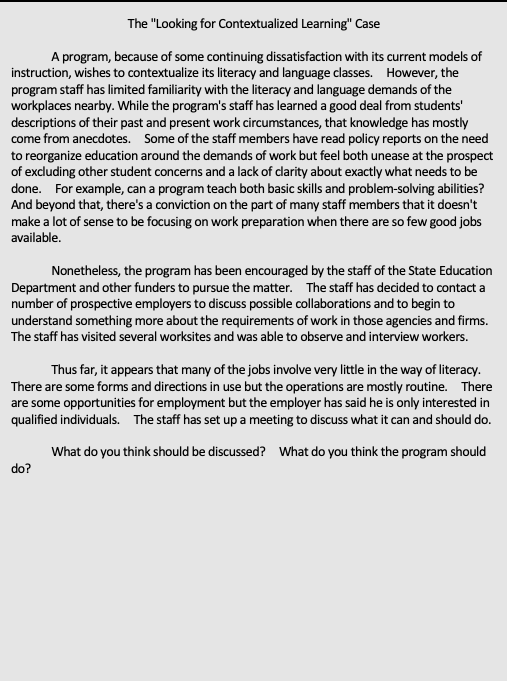As is reasonably well known, older adolescents and adults who have not completed high school can obtain an equivalency diploma by passing the GED Tests (the Tests of General Educational Development). A 2010 estimate by the U.S. Census Bureau placed the number of adults in New York State without high school diplomas at approximately 2,850,000. In 2011, according to the Annual Statistical Report published by the GED Testing Service, almost 44,000 individuals took the GED Tests in the state and 25,436 met the score requirements and were awarded a diploma. It is striking that so few individuals without a diploma (only 1.5% of the potential examinees) take the Tests but New York’s participation rate is not so dramatically different from most other states and no state, other than Alaska, exceeds 5%. In light of the emotional rewards associated with obtaining a diploma and the expanded opportunities that a diploma creates, we are long overdue for a serious study about why those who we think should be interested in pursuing a diploma do not. But that’s a subject for another essay.
For the moment, I’d like to focus on what many perceive as the desperate situation facing GED students and GED preparation programs. In 2010, the organization that had been responsible for the development of the GED Tests for more than half a century, the American Council on Education (ACE), announced that it had decided to terminate its work on the development of a new test series and, instead, to pursue the development of a fundamentally different exam that would be more explicitly linked to assessments of college readiness. This new orientation was not so surprising since the GED Testing Service had long maintained that an equivalency diploma opened doors to postsecondary study. However, in late 2009, the Testing Service had published a research report that indicated that the door opening had not amounted to much. The researchers tracked the postsecondary outcomes of a random sample of 1,000 individuals who had completed the GED test in 2003. Of those 1,000 test-takers,
- 307 enrolled in at least one postsecondary institution by fall 2008;
- 77% of those individuals dropped out after one semester;
- Only 17 individuals earned a postsecondary credential by 2008.
The next announcement from the Testing Service, however, was a dramatic surprise. ACE announced that it had forged a public/private partnership with Pearson Publishers to develop the new exam. Although not highlighted in the initial announcement, it has since become clear that the price of the partnership will be a heavy one for test-takers in states that charge fees for the exams or for public education agencies in states, such as New York, that make the exam available free of charge. Current estimates are that each exam will cost about $120. Worries about the additional costs have led New York and a number of other states to launch efforts intended to find an alternative to the new GED Tests. Thus far, to the best of my knowledge, most discussions have been preoccupied with finding alternative exams. I’d like to propose a quite different kind of alternative—an alternative that will probably not be less expensive but could be much better.
The desire of GED diploma holders to pursue postsecondary study is evident at the City University of New York. In recent years, approximately 4,000 GED graduates have entered the University as full-time freshmen annually—amounting to about 9% of the total. However, most do not earn a credential. For students who entered college in fall 2001, only 12% had earned a degree or certificate within four years. In part, the lack of success of GED diploma holders can be ascribed to their need to take remedial courses–especially in math and writing. For example, in the years from 2001 to 2007, only 13% of GED entrants did not require remedial courses.
Concerns about the academic preparedness of GED entrants are not new. In 1991, when I was working in the Division of Adult and Continuing Education at CUNY’s Central Office, we initiated a comprehensive re-design of our GED preparation programs to insure that coursework included substantial reading, writing and math work rather than skill-focused exam prep. Students were encouraged to prepare themselves to obtain a high score on the Tests rather than just to pass. Most students, even though, as we will see below, completed one or more years of high school, were not ready to take the Tests and to obtain a high score on them without substantial preparation. [1] In the years since, the University has devoted substantial time and energy to the enrichment of its pre-GED and GED curricula and, in most instances, offers consistently high quality instruction. But, especially in recent years, it became clear that more needed to be done for those intending to enroll in college. A few individuals at CUNY began work on what was first called the College Transition Program, then the College Transition Initiative and now CU NY START. While the current much expanded program enrolls mostly high school graduates, much of its core academic model was based on an assessment of the distinctive needs of GED graduates.
I’d like to propose that the city and state might respond to the challenge of an unacceptably expensive testing program and a thoughtful assessment of the abilities and needs of those who have not completed high school by building upon the work that has been completed at CUNY. Specifically, I propose the creation of University-based Adult Academies, which would offer a program of study leading to a regular high school diploma. For many students, this would primarily be a high school completion program. Of the individuals taking the GED Tests across the United States in 2011, approximately 89% had completed some high school (18.1% had completed ninth grade; 27.3% had completed tenth grade; 34.3% had completed eleventh grade and 9.4% had completed twelfth grade).[2] As a result, it is likely that many test-takers had earned credits toward graduation before leaving high school. Such Academies would not offer courses designed to replicate high school courses, but the academic content of the courses and the range of subject matter could be comparable in every regard with the demands of college preparatory high school work. In addition, all of the courses could be designed to support the development of the multiple dimensions of college readiness identified by researchers such as David Conley.
I have a few preliminary ideas about the design of such academies:
- Students would obtain credit for a course by completing the course requirements–completing reading assignments, taking tests, writing reports, making presentations, producing products.
- In light of New York State’s adoption of the Common Core Standards, those standards would be utilized both to guide teachers and to inform students.
- In order to ensure that the quality of work expected from students was at least as high as that produced by high school graduates, the Academies’ staff would work closely with high school and college faculty members to develop standards and review samples of student work.
- Students’ academic programs would be mapped out on the basis of a careful review of high school transcripts and a comprehensive assessment of their reading, writing and math skills (about which I would have much more to say if there’s much positive response to this proposal).
- Course prototypes would be developed through consultations with and reviews by disciplinary experts, high school and college teachers, as well as GED and college transition teachers.
I’d welcome comments and suggestions.
[1] I should note that this proposal is, in part, based on a proposal that I wrote in the mid-1990s in an unsuccessful pursuit of funding,
[2] For 2011, data on New York State participants was not available; however, in previous years, New York data was closely aligned with national data.



Leave a Reply